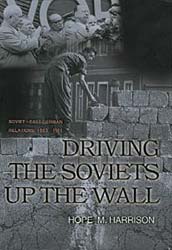|

Russian Relations
 Drawing from interviews with senior U.S. and Russian officials, James M. Goldgeier—director of GW’s Institute for European, Russian, and Eurasian Studies and associate professor of political science and international affairs—writes a thoughtful, thorough account of the relationship between the United States and Russia during the last few turbulent decades in Power and Purpose: U.S. Policy Toward Russia after the Cold War (Brookings Institution Press, 2003). With co-author Michael McFaul, Goldgeier, who also is an adjunct senior fellow in Europe studies for the Council on Foreign Relations, explores the evolution of U.S. foreign policy toward the Soviet Union during the last three administrations. Drawing from interviews with senior U.S. and Russian officials, James M. Goldgeier—director of GW’s Institute for European, Russian, and Eurasian Studies and associate professor of political science and international affairs—writes a thoughtful, thorough account of the relationship between the United States and Russia during the last few turbulent decades in Power and Purpose: U.S. Policy Toward Russia after the Cold War (Brookings Institution Press, 2003). With co-author Michael McFaul, Goldgeier, who also is an adjunct senior fellow in Europe studies for the Council on Foreign Relations, explores the evolution of U.S. foreign policy toward the Soviet Union during the last three administrations.
Focusing on how policymakers faced challenges and capitalized on opportunities presented by a changing Russia, the book reveals the inner workings behind U.S. efforts to promote democracy and markets in Russia. By asking the right questions, Goldgeier shows how two superpowers—once bitter adversaries—followed an intricate and problematic path toward peace and security.
Social Security Man
 The life of the man who dedicated his career to developing and promoting Social Security is revealed in Robert Ball and the Politics of Social Security (Univeristy of Wisconsin Press, 2003) by Edward D. Berkowitz, professor of history and director of GW’s Program in History and Public Policy. From 1939 on, Ball was a key player in fostering Social Security, working as a field representative, commissioner of Social Security appointed by President Kennedy, serving as adviser to several administrations, and writing definitive statements on the subject. The biography, rooted in policy analysis, is based on Berkowitz’s exclusive access to Ball’s personal and professional papers and his oral memoir created specifically for the book. The life of the man who dedicated his career to developing and promoting Social Security is revealed in Robert Ball and the Politics of Social Security (Univeristy of Wisconsin Press, 2003) by Edward D. Berkowitz, professor of history and director of GW’s Program in History and Public Policy. From 1939 on, Ball was a key player in fostering Social Security, working as a field representative, commissioner of Social Security appointed by President Kennedy, serving as adviser to several administrations, and writing definitive statements on the subject. The biography, rooted in policy analysis, is based on Berkowitz’s exclusive access to Ball’s personal and professional papers and his oral memoir created specifically for the book.
Berkowitz describes how Social Security came to be the most important social welfare program in the United States, as well as Ball’s roll in its expansion and reform, and threats to the program’s existence. Though Berkowitz says Ball is “not an easy man to know,” he is able to describe Ball as someone who is very passionate about his beliefs and his work, a man whose “use of the conservative means of social insurance toward the liberal ends of an expanded welfare state has left an indelible mark on American social policy.”
Political Minds
Editor and author Jerrold M. Post and a group of expert contributors explore the vastly different psychological profiles and leadership styles of two political giants—President Clinton and Saddam Hussein—in The Psychological Assessment of Political Leaders (University of Michigan Press, 2003).
Post, professor of psychiatry, political psychology, and international affairs and director of GW’s Political Psychology Program, outlines a system of “at a distance evaluation,” gathering information from several disciplines including psycholinguistics and political psychology, to build the profiles. This system of analysis, applied to the two case studies, offers in-depth political psychological portraits and a “deeper understanding of the volatile circumstances of global affairs.”
The work is a timely effort to gain insight into the minds of two individuals who have shaped the modern world. The legacies of the works of the two men have had lasting effects on modern society and political policies. As Post, founder of the Center for the Analysis of Personality and Political Behavior, writes, “If we want to understand what they do, we had better have useful theories of why they do it.”
The Berlin Wall
 Assistant Professor of History and International Affairs Hope M. Harrison writes a gripping account of Soviet-East German relations from 1953 to 1961 in Driving the Soviets up the Wall, (Princeton University Press, 2003). Harrison offers the provocative argument that the East Germans pushed the reluctant Soviets into building the Berlin Wall: “The East German factor was much more important than previously recognized and indeed is an essential part of the story. The East Germans, through their own policies, narrowed Soviet options and also took advantage of tensions in U.S.-Soviet and Sino-Soviet relations, as well as tensions within the Soviet leadership.” Assistant Professor of History and International Affairs Hope M. Harrison writes a gripping account of Soviet-East German relations from 1953 to 1961 in Driving the Soviets up the Wall, (Princeton University Press, 2003). Harrison offers the provocative argument that the East Germans pushed the reluctant Soviets into building the Berlin Wall: “The East German factor was much more important than previously recognized and indeed is an essential part of the story. The East Germans, through their own policies, narrowed Soviet options and also took advantage of tensions in U.S.-Soviet and Sino-Soviet relations, as well as tensions within the Soviet leadership.”
Harrison, who served as director for European and Eurasian Affairs at the National Security Council from 2000 to 2001, offers information that sheds a different light on the nature of relations between countries of the Soviet block at the height of the Cold War, while also contributing to the ongoing dialogue about the ability of weaker states to influence their stronger allies.
Military Motives
It was not current events but rather events of the previous decade that prompted Martha Finnemore, associate professor of political science and international affairs, to write The Purpose of Intervention: Changing Beliefs about the Use of Force (Cornell University Press, 2003).
“The UN-orchestrated military interventions in places like Somalia and Bosnia, which were proliferating in the 1990s, looked qualitatively new then and raised important questions for international relations scholars,” she writes.
Military intervention was indeed changing in the 1990s, she notes. Examining trends and changes during the past 400 years, Finnemore focuses on three types of intervention: acting against perceived threats to international peace, collecting debts, and addressing humanitarian crises to sketch a picture of how and why the use of force has changed.
—Laura Ewald and Heather O. Milke
Back to top | Spring 2004 Table of Contents
|